Page 101 of 620
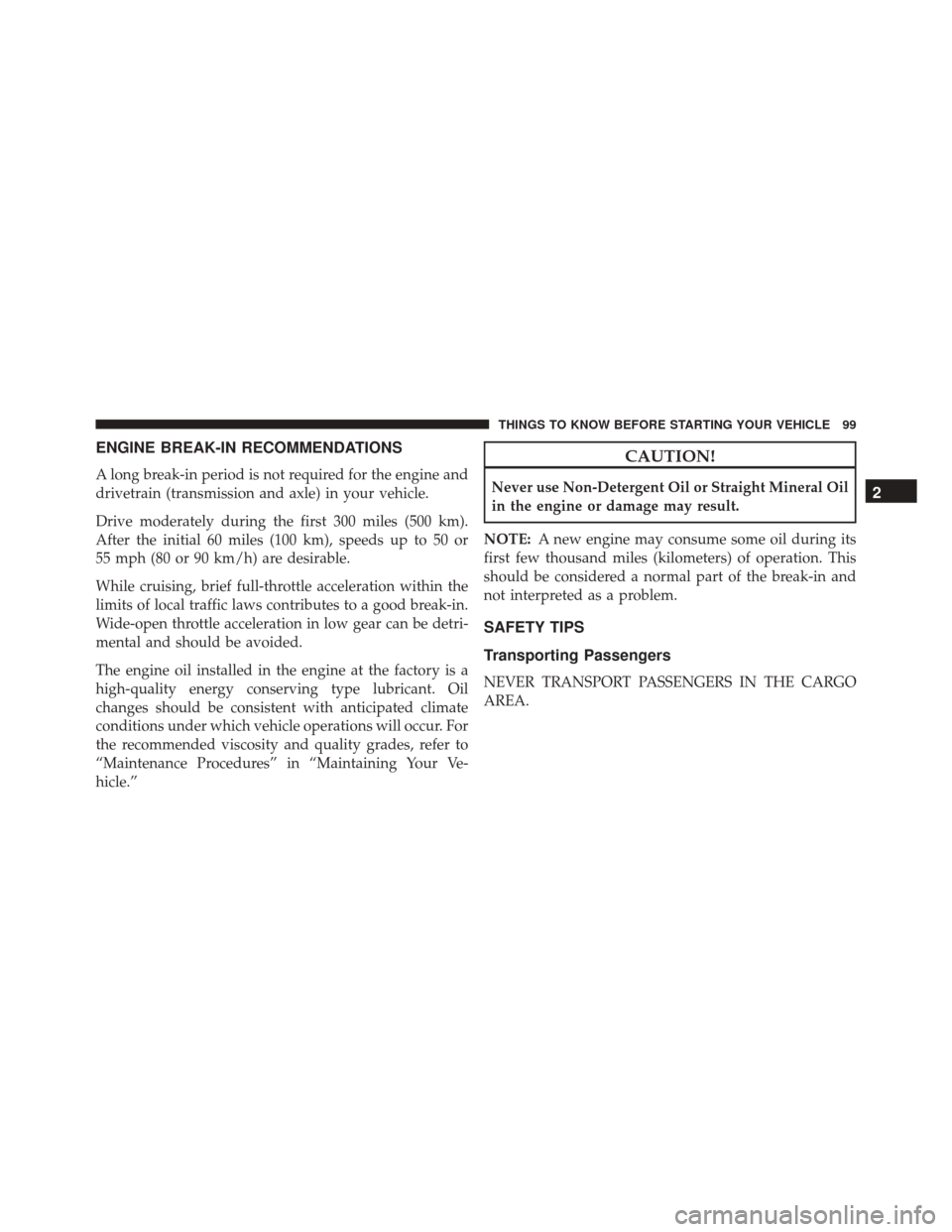
ENGINE BREAK-IN RECOMMENDATIONS
A long break-in period is not required for the engine and
drivetrain (transmission and axle) in your vehicle.
Drive moderately during the first 300 miles (500 km).
After the initial 60 miles (100 km), speeds up to 50 or
55 mph (80 or 90 km/h) are desirable.
While cruising, brief full-throttle acceleration within the
limits of local traffic laws contributes to a good break-in.
Wide-open throttle acceleration in low gear can be detri-
mental and should be avoided.
The engine oil installed in the engine at the factory is a
high-quality energy conserving type lubricant. Oil
changes should be consistent with anticipated climate
conditions under which vehicle operations will occur. For
the recommended viscosity and quality grades, refer to
“Maintenance Procedures” in “Maintaining Your Ve-
hicle.”
CAUTION!
Never use Non-Detergent Oil or Straight Mineral Oil
in the engine or damage may result.
NOTE: A new engine may consume some oil during its
first few thousand miles (kilometers) of operation. This
should be considered a normal part of the break-in and
not interpreted as a problem.
SAFETY TIPS
Transporting Passengers
NEVER TRANSPORT PASSENGERS IN THE CARGO
AREA.
2
THINGS TO KNOW BEFORE STARTING YOUR VEHICLE 99
Page 289 of 620
Electronic Stability Control (ESC) OFF Indicator Light — If Equipped
Yellow TelltaleLight What It Means
Electronic Stability Control (ESC) OFF Indicator Light
This light indicates the Electronic Stability Control (ESC) is off.
With Drive Modes the ESC OFF indicator will be lit any time the Traction modes is set to
Sport, Track or Full OFF.
Low Washer Fluid Indicator Light — If Equipped
Yellow Telltale
Light What It Means
Low Washer Fluid Indicator Light — If Equipped
This indicator will illuminate when the windshield washer fluid is low.
4
UNDERSTANDING YOUR INSTRUMENT PANEL 287
Page 373 of 620
STARTING AND OPERATING
CONTENTS
�STARTING PROCEDURES ................376
▫ Automatic Transmission ................377
▫ Keyless Enter-N-Go ...................377
▫ Normal Starting ...................... .378
▫ Extreme Cold Weather
(Below –22°F Or �30°C) ................379
▫ If Engine Fails To Start .................380
▫ After Starting ....................... .381
� ENGINE BLOCK HEATER — IF EQUIPPED . . .381
� AUTOMATIC TRANSMISSION ............381▫
Key Ignition Park Interlock ...............383
▫ Brake/Transmission Shift Interlock System . . .383
▫ Eight-Speed Automatic Transmission .......384
� AUTOSTICK — IF EQUIPPED .............391
� SPORT MODE — IF EQUIPPED ............394
� ALL-WHEEL DRIVE (AWD) — IF EQUIPPED . .394
� DRIVING ON SLIPPERY SURFACES .........395
▫ Acceleration ........................ .395
▫ Traction ........................... .396
� DRIVING THROUGH WATER .............396
5
Page 391 of 620
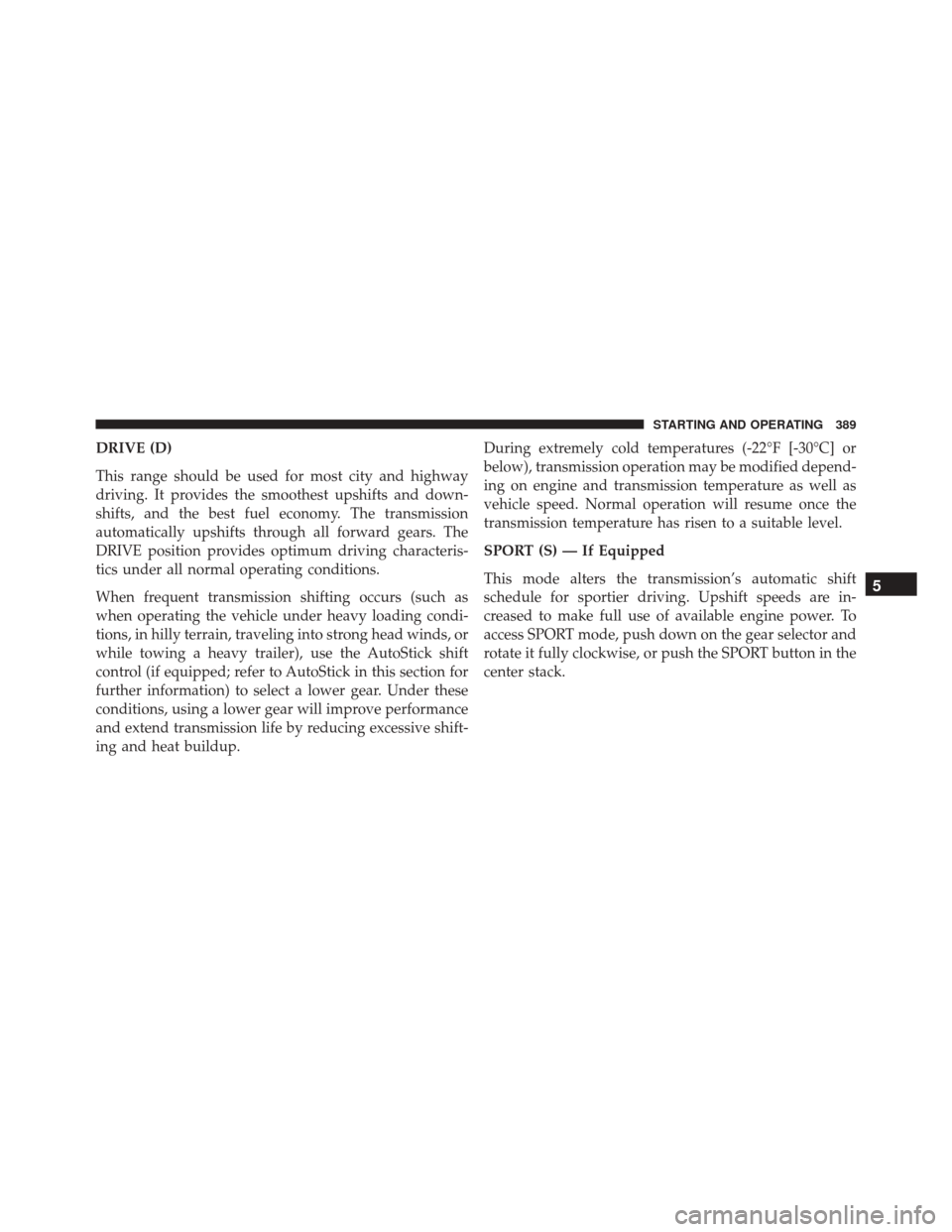
DRIVE (D)
This range should be used for most city and highway
driving. It provides the smoothest upshifts and down-
shifts, and the best fuel economy. The transmission
automatically upshifts through all forward gears. The
DRIVE position provides optimum driving characteris-
tics under all normal operating conditions.
When frequent transmission shifting occurs (such as
when operating the vehicle under heavy loading condi-
tions, in hilly terrain, traveling into strong head winds, or
while towing a heavy trailer), use the AutoStick shift
control (if equipped; refer to AutoStick in this section for
further information) to select a lower gear. Under these
conditions, using a lower gear will improve performance
and extend transmission life by reducing excessive shift-
ing and heat buildup.During extremely cold temperatures (-22°F [-30°C] or
below), transmission operation may be modified depend-
ing on engine and transmission temperature as well as
vehicle speed. Normal operation will resume once the
transmission temperature has risen to a suitable level.
SPORT (S) — If Equipped
This mode alters the transmission’s automatic shift
schedule for sportier driving. Upshift speeds are in-
creased to make full use of available engine power. To
access SPORT mode, push down on the gear selector and
rotate it fully clockwise, or push the SPORT button in the
center stack.
5
STARTING AND OPERATING 389
Page 393 of 620
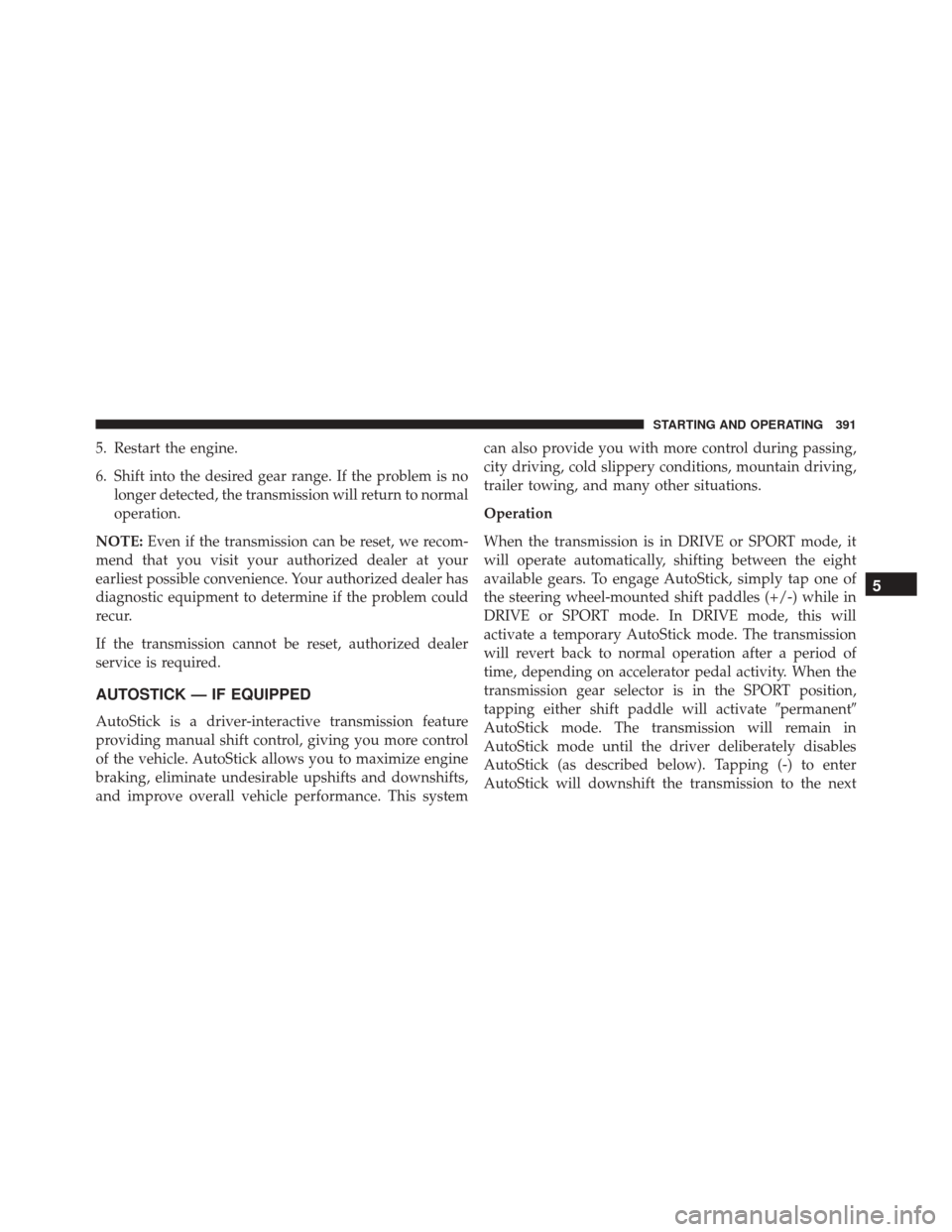
5. Restart the engine.
6. Shift into the desired gear range. If the problem is nolonger detected, the transmission will return to normal
operation.
NOTE: Even if the transmission can be reset, we recom-
mend that you visit your authorized dealer at your
earliest possible convenience. Your authorized dealer has
diagnostic equipment to determine if the problem could
recur.
If the transmission cannot be reset, authorized dealer
service is required.
AUTOSTICK — IF EQUIPPED
AutoStick is a driver-interactive transmission feature
providing manual shift control, giving you more control
of the vehicle. AutoStick allows you to maximize engine
braking, eliminate undesirable upshifts and downshifts,
and improve overall vehicle performance. This system can also provide you with more control during passing,
city driving, cold slippery conditions, mountain driving,
trailer towing, and many other situations.
Operation
When the transmission is in DRIVE or SPORT mode, it
will operate automatically, shifting between the eight
available gears. To engage AutoStick, simply tap one of
the steering wheel-mounted shift paddles (+/-) while in
DRIVE or SPORT mode. In DRIVE mode, this will
activate a temporary AutoStick mode. The transmission
will revert back to normal operation after a period of
time, depending on accelerator pedal activity. When the
transmission gear selector is in the SPORT position,
tapping either shift paddle will activate
�permanent�
AutoStick mode. The transmission will remain in
AutoStick mode until the driver deliberately disables
AutoStick (as described below). Tapping (-) to enter
AutoStick will downshift the transmission to the next
5
STARTING AND OPERATING 391
Page 394 of 620
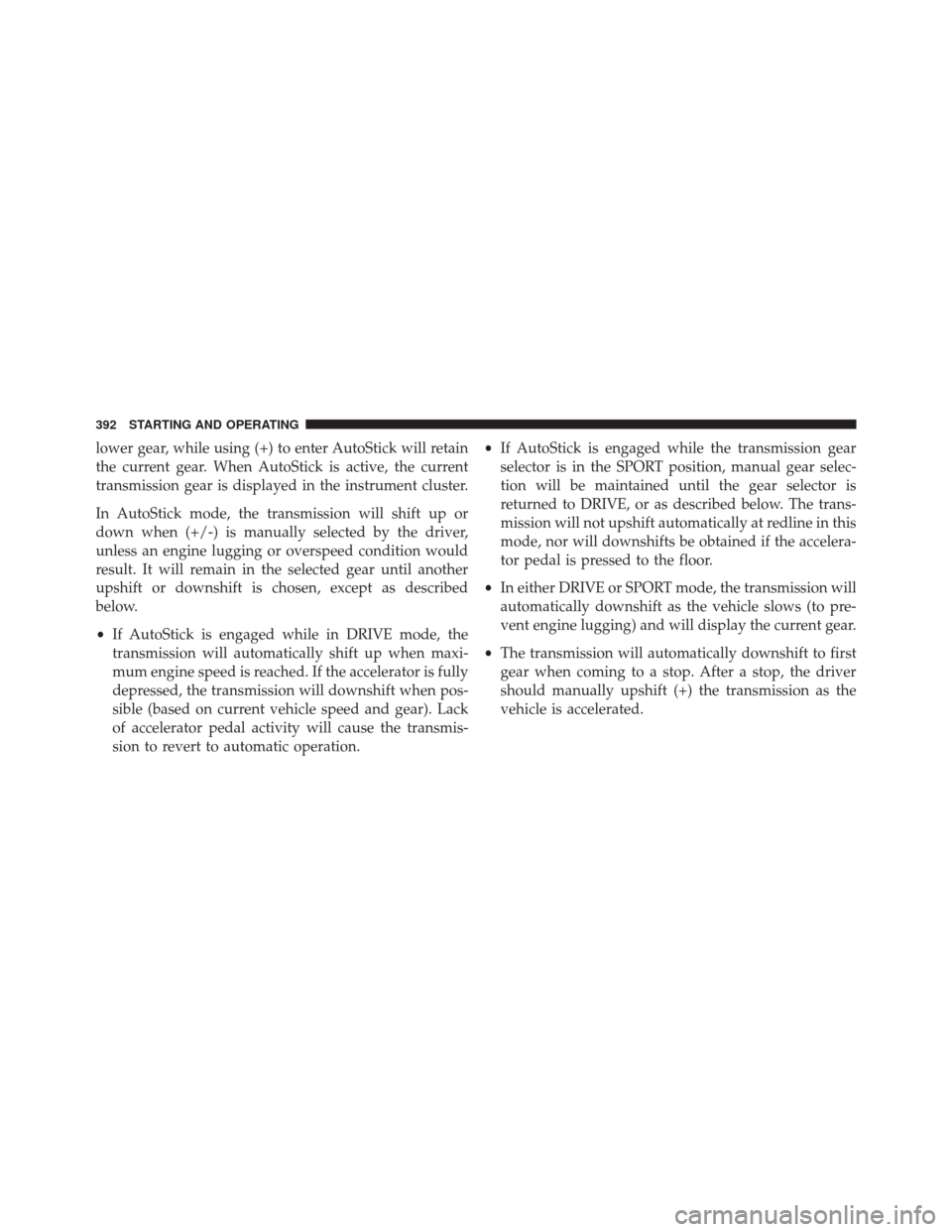
lower gear, while using (+) to enter AutoStick will retain
the current gear. When AutoStick is active, the current
transmission gear is displayed in the instrument cluster.
In AutoStick mode, the transmission will shift up or
down when (+/-) is manually selected by the driver,
unless an engine lugging or overspeed condition would
result. It will remain in the selected gear until another
upshift or downshift is chosen, except as described
below.
•If AutoStick is engaged while in DRIVE mode, the
transmission will automatically shift up when maxi-
mum engine speed is reached. If the accelerator is fully
depressed, the transmission will downshift when pos-
sible (based on current vehicle speed and gear). Lack
of accelerator pedal activity will cause the transmis-
sion to revert to automatic operation. •
If AutoStick is engaged while the transmission gear
selector is in the SPORT position, manual gear selec-
tion will be maintained until the gear selector is
returned to DRIVE, or as described below. The trans-
mission will not upshift automatically at redline in this
mode, nor will downshifts be obtained if the accelera-
tor pedal is pressed to the floor.
• In either DRIVE or SPORT mode, the transmission will
automatically downshift as the vehicle slows (to pre-
vent engine lugging) and will display the current gear.
• The transmission will automatically downshift to first
gear when coming to a stop. After a stop, the driver
should manually upshift (+) the transmission as the
vehicle is accelerated.
392 STARTING AND OPERATING
Page 395 of 620
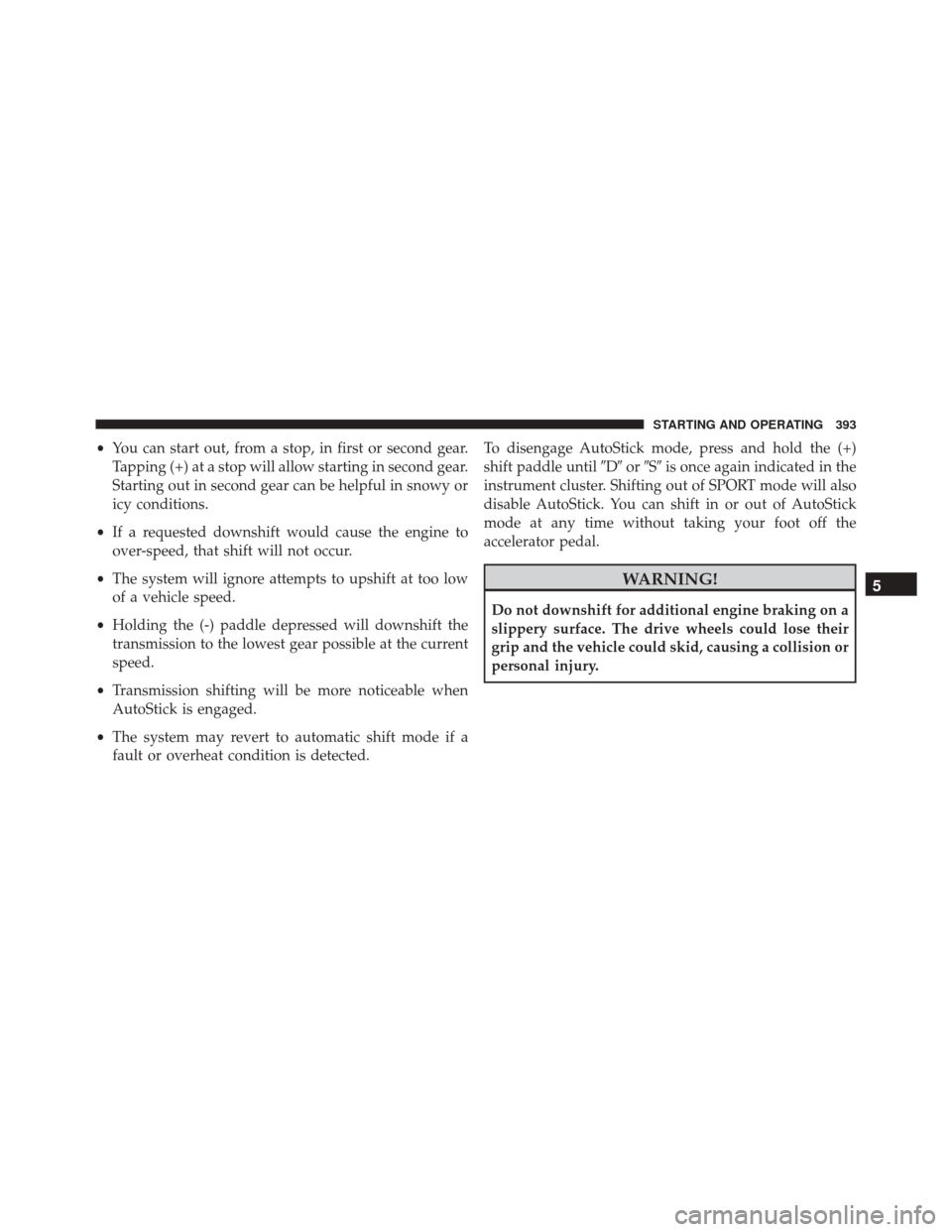
•You can start out, from a stop, in first or second gear.
Tapping (+) at a stop will allow starting in second gear.
Starting out in second gear can be helpful in snowy or
icy conditions.
• If a requested downshift would cause the engine to
over-speed, that shift will not occur.
• The system will ignore attempts to upshift at too low
of a vehicle speed.
• Holding the (-) paddle depressed will downshift the
transmission to the lowest gear possible at the current
speed.
• Transmission shifting will be more noticeable when
AutoStick is engaged.
• The system may revert to automatic shift mode if a
fault or overheat condition is detected. To disengage AutoStick mode, press and hold the (+)
shift paddle until
�D�or�S� is once again indicated in the
instrument cluster. Shifting out of SPORT mode will also
disable AutoStick. You can shift in or out of AutoStick
mode at any time without taking your foot off the
accelerator pedal.
WARNING!
Do not downshift for additional engine braking on a
slippery surface. The drive wheels could lose their
grip and the vehicle could skid, causing a collision or
personal injury.
5
STARTING AND OPERATING 393
Page 396 of 620
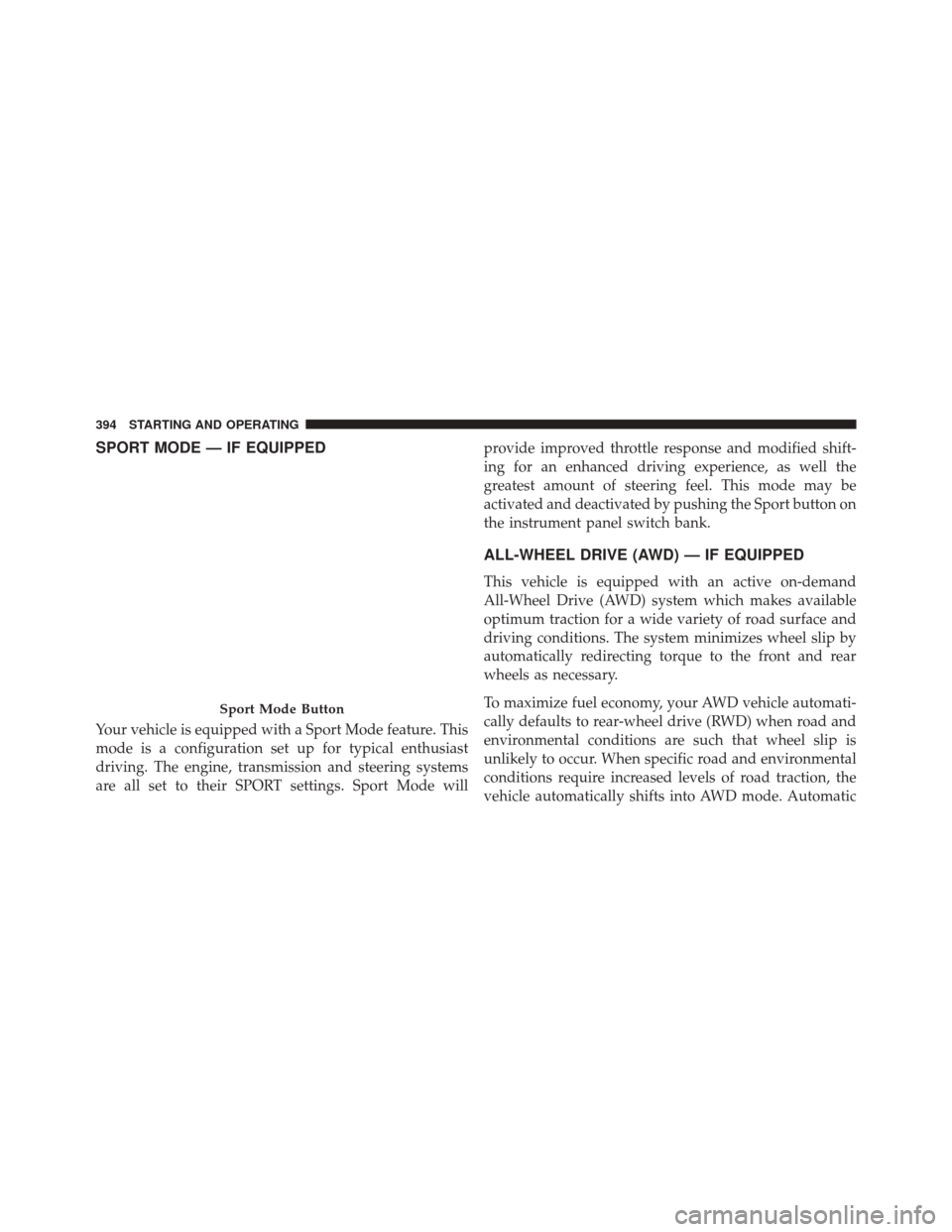
SPORT MODE — IF EQUIPPED
Your vehicle is equipped with a Sport Mode feature. This
mode is a configuration set up for typical enthusiast
driving. The engine, transmission and steering systems
are all set to their SPORT settings. Sport Mode willprovide improved throttle response and modified shift-
ing for an enhanced driving experience, as well the
greatest amount of steering feel. This mode may be
activated and deactivated by pushing the Sport button on
the instrument panel switch bank.
ALL-WHEEL DRIVE (AWD) — IF EQUIPPED
This vehicle is equipped with an active on-demand
All-Wheel Drive (AWD) system which makes available
optimum traction for a wide variety of road surface and
driving conditions. The system minimizes wheel slip by
automatically redirecting torque to the front and rear
wheels as necessary.
To maximize fuel economy, your AWD vehicle automati-
cally defaults to rear-wheel drive (RWD) when road and
environmental conditions are such that wheel slip is
unlikely to occur. When specific road and environmental
conditions require increased levels of road traction, the
vehicle automatically shifts into AWD mode. Automatic
Sport Mode Button
394 STARTING AND OPERATING